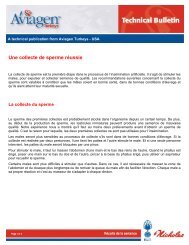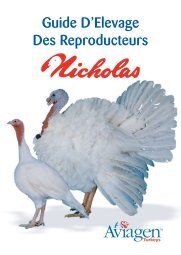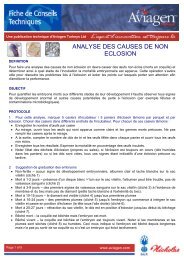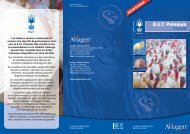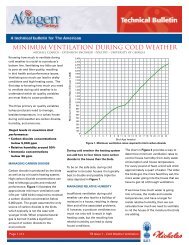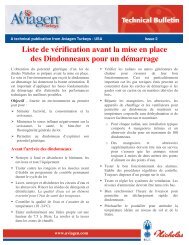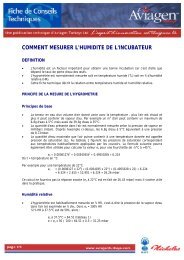Feeding Guidelines for Nicholas and B.U.T. ... - Aviagen Turkeys
Feeding Guidelines for Nicholas and B.U.T. ... - Aviagen Turkeys
Feeding Guidelines for Nicholas and B.U.T. ... - Aviagen Turkeys
You also want an ePaper? Increase the reach of your titles
YUMPU automatically turns print PDFs into web optimized ePapers that Google loves.
<strong>Feeding</strong> <strong>Guidelines</strong> <strong>for</strong><br />
<strong>Nicholas</strong> <strong>and</strong> B.U.T. Heavy Lines
FEEDING GUIDELINES FOR<br />
NICHOLAS AND B.U.T. HEAVY LINES<br />
The nutritional guidelines provided in the following tables have been<br />
revised according to:<br />
• the latest results from trials conducted as part of <strong>Aviagen</strong>’s ongoing<br />
nutrition research programmes<br />
• published scientific in<strong>for</strong>mation<br />
• current management practices<br />
• the latest revision of the per<strong>for</strong>mance goals<br />
The optimum feed programme <strong>for</strong> any stock will depend on many<br />
management, environmental <strong>and</strong> economic conditions that may differ<br />
from those under which the nutritional guidelines were tested. The<br />
nutritional guidelines are there<strong>for</strong>e intended <strong>for</strong> use as a guide only <strong>and</strong><br />
should not be considered a guarantee with respect to body weight or<br />
other production targets.<br />
<strong>Feeding</strong> Programmes<br />
The recommended schedules split the turkeys life into seven phases.<br />
The objective is to provide the optimum balance of nutrients <strong>for</strong> the<br />
development of the turkey within that time period.<br />
There may be good reasons to use different phases of feeding due to<br />
management <strong>and</strong> other issues so these guidelines can be regarded as a<br />
tool that can be used to construct feeding programmes that apply to each<br />
company’s requirements.<br />
The more diets there are in the feeding programme the more efficiently<br />
the feeding schedule will match the bird’s requirements.<br />
An Excel spreadsheet is available on the <strong>Aviagen</strong> <strong>Turkeys</strong> website that<br />
will the enable user to easily calculate a suitable feeding schedule based<br />
on the data shown in this booklet.<br />
PAGE 3
Feed Density<br />
The recommended schedules split the turkeys life into seven phases.<br />
The objective is to provide the optimum balance of nutrients <strong>for</strong> the<br />
development of the turkey within that time period.<br />
The guidelines in Table 1 assume a fixed relationship between diet energy<br />
<strong>and</strong> nutrient levels in each phase. The decision on what energy density<br />
should be used needs to take into account several factors:<br />
• Economics<br />
- current <strong>and</strong> future prices <strong>for</strong> feed <strong>and</strong> feed ingredients<br />
- current <strong>and</strong> future prices <strong>for</strong> sales of the meat <strong>and</strong> products<br />
• The objectives of the company or farmer<br />
- lowest cost of liveweight production<br />
- least cost deboned breast meat<br />
- maximised yield from the facilities<br />
- lowest FCR<br />
• Health status of the turkeys<br />
- in areas of high disease challenge higher density nutrition can help<br />
to support the turkeys during periods of risk.<br />
- in periods of enteric upset a lower density ration can reduce<br />
diarrhoea problems.<br />
• Weather conditions<br />
- in hot weather feed intake may be reduced with a consequence of<br />
lower weights or meat yields.<br />
PAGE 4
Feed Composition<br />
Energy<br />
<strong>Turkeys</strong> require energy <strong>for</strong> growth of tissue, maintenance <strong>and</strong> activity.<br />
Carbohydrate sources, such as corn <strong>and</strong> wheat, <strong>and</strong> various fats or oils are<br />
the major source of energy in poultry feeds. Energy levels in diets are<br />
expressed in Megajoules (MJ/kg) or kilocalories (kcal/kg) of Metabolisable<br />
Energy (ME), as this represents the energy available to the turkey.<br />
Protein<br />
Feed proteins, such as those in cereals <strong>and</strong> soybean meal, are complex<br />
compounds which are broken down by digestion into amino acids. These<br />
amino acids are absorbed <strong>and</strong> assembled into body proteins which are used<br />
in the construction of body tissue, e.g. muscles, nerves, skin <strong>and</strong> feathers.<br />
Dietary crude protein levels do not indicate the quality of the proteins in<br />
feed ingredients. Diet protein quality is based on the level, balance <strong>and</strong><br />
digestibility of essential amino acids in the final mixed feed.<br />
Macro Minerals<br />
The provision of the correct levels of the major minerals in the appropriate<br />
balance is important <strong>for</strong> all turkeys. The macro minerals involved are<br />
calcium, phosphorus, sodium, potassium <strong>and</strong> chloride.<br />
Calcium <strong>and</strong> Phosphorus:<br />
Calcium influences growth, feed efficiency, bone development, leg health,<br />
nerve function <strong>and</strong> the immune system. It is vital that calcium is supplied<br />
in adequate quantities <strong>and</strong> on a consistent basis. Phosphorus, like calcium,<br />
is required in the correct <strong>for</strong>m <strong>and</strong> quantity to optimise skeletal structure<br />
<strong>and</strong> growth.<br />
Sodium, Potassium <strong>and</strong> Chloride:<br />
These minerals are needed <strong>for</strong> general metabolic functions. Shortages can<br />
affect feed intake, growth <strong>and</strong> blood pH. Excess levels of these minerals<br />
result in increased water intake <strong>and</strong> subsequent poor litter quality.<br />
PAGE 5
Trace Minerals <strong>and</strong> Vitamins<br />
Trace minerals <strong>and</strong> vitamins are needed <strong>for</strong> all metabolic functions.<br />
Appropriate vitamin <strong>and</strong> trace mineral supplementation depends on the<br />
feed ingredients used, the feed manufacture <strong>and</strong> on local circumstances.<br />
Due to differences in vitamin levels of various cereals, the level of<br />
supplementation of some vitamins must be modified. Accordingly,<br />
separate guidelines are usually proposed <strong>for</strong> some vitamins, depending<br />
on the cereals (e.g. wheat versus maize) upon which the diets are based.<br />
See Table 3.<br />
Enzymes<br />
Two types of enzyme are generally used in turkey diets:<br />
NSP Enzymes:-<br />
Cereals contain some none starch polysaccharides (NSP) as part of the<br />
carbohydrate complex. The type <strong>and</strong> levels of NSPs varies in different<br />
cereals: Rye having the highest levels <strong>and</strong> Maize the lowest. These NSPs<br />
cannot be readily digested by turkeys due to the lack of natural enzymes<br />
to break them down, <strong>and</strong> then they <strong>for</strong>m complexes in the gut resulting<br />
in poorer digestion <strong>and</strong> problematic faeces.<br />
The addition of NSP enzymes in the feed, targeted at the specific cereal<br />
being used, can improve digestion <strong>and</strong> release extra energy <strong>and</strong> minerals<br />
<strong>for</strong> absorption by the turkey.<br />
Phytase Enzymes:-<br />
Ingredients of plant origin contain a lot of phosphorus which is naturally<br />
bound into a Phytate molecule. <strong>Turkeys</strong> cannot access this phosphorus<br />
as they lack an enzyme to break down the complex.<br />
Addition of a Phytase enzyme to the diet releases some of the<br />
phosphorus <strong>and</strong> calcium, which reduces the need to add additional<br />
minerals to the feed <strong>and</strong> reduces phosphate pollution if the litter is used<br />
as a fertilizer.<br />
PAGE 6
Feed Ingredients<br />
Attention should also be paid to the quality <strong>and</strong> digestibility of dietary<br />
protein.<br />
The inclusion of fishmeal in diets <strong>for</strong> young turkeys, where permitted<br />
under local regulations, helps to improve the amino acid balance <strong>and</strong><br />
reduce the risks from over reliance on Soya. The use of ingredients with<br />
protein of poor digestibility should be restricted. Excess of undigested<br />
protein will be excreted causing an increased litter ammonia<br />
concentration. This may increase the incidence of breast condemnations<br />
or cause environmental nuisance.<br />
Fats are an important energy source in turkey diets but young turkeys<br />
have a limited capacity to digest some of the fatty acids found in some<br />
types of fat. Generally the use of pure vegetable fats like Soyabean oil is<br />
recommended <strong>for</strong> starter diets <strong>and</strong> the proportion of lower quality fats or<br />
Blends with high levels of free fatty acids or high in palmitic or stearic<br />
acid should be restricted until the birds get older.<br />
Table 4 shows guidelines <strong>for</strong> the inclusion of some feed ingredients.<br />
Feed Structure<br />
In the first 24 -72 hours it is very important to get the poults to consume<br />
as much food as possible. Early management in terms of feed<br />
presentation, lighting <strong>and</strong> temperature must encourage the poults to eat.<br />
To start the poults the diet needs to have enough structure to enable the<br />
young birds to pick up particles. If it is too fine <strong>and</strong> dusty then the poults<br />
may not be able to select enough particles <strong>and</strong> will not consume enough;<br />
however if the particles are too large then the poults will not be able to<br />
swallow them <strong>and</strong> so will not eat enough food to get them off to a good<br />
start.<br />
The starter feed should be presented as a coarsely ground meal or a<br />
sieved crumble made from hard pellets of a maximum diameter of 3.5<br />
mm. Small diameter pellets 1.5-2.0 mm can be used, but the pellets<br />
should not be longer than the diameter.<br />
PAGE 7
As the poults get older the grist or crumble size can be coarser, <strong>and</strong> small<br />
diameter pellets (3.5 mm) can be introduced after 21 days.<br />
To manufacture good pellets <strong>and</strong> crumbles many feedmills will grind the<br />
ingredients to a fine powder to improve the cohesion when it is<br />
conditioned <strong>and</strong> pelleted. When the turkey consumes these pellets or<br />
crumbles the processed feed will dissolve into a fine paste in the crop<br />
when mixed with water, this then passes in the gizzard. The gizzard<br />
should act to further process the feed by grinding it down, but without<br />
any coarse structure the gizzard muscles do not develop <strong>and</strong> the enzyme<br />
production is low. Using coarsely ground cereals or adding whole or<br />
cracked grains of cereals to the diet will stimulate the gizzard to develop<br />
naturally <strong>and</strong> will increase enzyme production, improve food utilisation,<br />
improve litter conditions <strong>and</strong> help to reduce enteric problems.<br />
Whole Grain<br />
The addition of whole grain to the diets helps improve gut integrity <strong>and</strong><br />
allows the producer some flexibility in adjusting diet composition <strong>and</strong><br />
controlling cost.<br />
There are different ways that whole grain is now used to feed turkeys:-<br />
1. In a controlled way when grain is added at fixed levels <strong>and</strong> the diets<br />
are adjusted to take account of this so that the correct nutrient<br />
package is consumed. The inclusion of whole grains can be at the<br />
feedmill or on the farm using blending systems.<br />
2. Another method is using whole grain to dilute the diet. This may be at<br />
controlled or uncontrolled levels. In a controlled programme a series<br />
of addition levels of the whole grain can be calculated to ensure the<br />
overall combination of feed <strong>and</strong> grain matches reasonably closely the<br />
turkeys’ requirements. However in an uncontrolled programme the<br />
level added may be dictated by the farmers reaction to bird weight or<br />
per<strong>for</strong>mance. The level of grain added may be varied according to the<br />
desired outcome using on farm blending systems. Dilution of the diet<br />
can lead to suboptimal per<strong>for</strong>mance, but can also result in a reduced<br />
cost of gain. Such programmes need close coordination between<br />
growers <strong>and</strong> processors to achieve common objectives.<br />
PAGE 8
ADVANTAGES OF WHOLE GRAIN ADDITION<br />
• Reduces feed cost by reducing milling charge <strong>and</strong> if added on farm<br />
reduces transport costs<br />
• Less rations to be manufactured<br />
• Fewer deliveries where on farm grain is used, since up to 25% of<br />
diet can be whole grain<br />
• Improved gut health<br />
• Better litter quality<br />
• Lower FCR<br />
• When added on-farm the levels can be adjusted based on actual<br />
per<strong>for</strong>mance levels, so that growth can be controlled<br />
• Can be used to reduce growth in older males if there are risks of<br />
leg problems or heart attacks<br />
DISADVANTAGES OF WHOLE GRAIN ADDITION<br />
• Salmonella can be present in whole grain so the grain should be<br />
treated with organic acid<br />
• On-farm grain stores must be vermin/water proof<br />
• Blending systems are expensive, involving capital expenditure<br />
• Wheat quality may vary <strong>and</strong> should be tested routinely<br />
(eg. moisture <strong>and</strong> specific weight)<br />
• Growth rate may be reduced<br />
• Breastmeat may be reduced if the diet is not balanced<br />
• The gizzard increases in size leading to higher losses at processing<br />
• Potential <strong>for</strong> contamination from grain in the processing plant<br />
• Coccidiostat levels need to be adjusted in the feed to allow <strong>for</strong><br />
dilution<br />
PAGE 9
FEEDING GUIDELINES FOR HEAVY LINES<br />
<strong>Feeding</strong> Programme<br />
In Table 1 the guideline amino acids <strong>and</strong> mineral levels <strong>for</strong> feeding to<br />
<strong>Aviagen</strong> Heavy line turkeys are shown. The nutrients are expressed as a<br />
function of the energy level of the feed expressed in g/Mj of<br />
metabolisable energy. The in<strong>for</strong>mation is set out based on a 7 stage<br />
feeding programme <strong>for</strong> males <strong>and</strong> females. From this table the user can<br />
calculate feeding programmes to suit their own situation<br />
Feed density is determined by the energy level of the feed. The selection<br />
of suitable energy levels should be based on many factors, such as<br />
market prices <strong>for</strong> feed ingredients, breast meat price, live bird price <strong>and</strong><br />
desired per<strong>for</strong>mance level. These factors will be specific to individual<br />
companies <strong>and</strong> outside the scope of these guidelines.<br />
Examples of a low, medium <strong>and</strong> high density programmes are shown in<br />
Tables 2A, 2B, 2C, to illustrate the sort of programmes that can be used in<br />
different situations. This in<strong>for</strong>mation is based on a 7 stage feeding<br />
programme, but to suit local conditions <strong>and</strong> management practices it is<br />
possible to adjust the feeding ages to whatever is most suitable providing the<br />
guideline principles are followed. To help in this process a feed calculator has<br />
been developed <strong>and</strong> is described on Page 12 in more detail.<br />
The more rations that are in the feeding programme the more efficiently<br />
the schedule will match the turkeys requirements. This may need to be<br />
balanced against practical considerations of producing <strong>and</strong> delivering<br />
many rations in a feedmill. However increased numbers of diets can be<br />
achieved without too much complication by blending diets or whole grain<br />
at the load point to increase ration numbers.<br />
Diets <strong>for</strong> Females – in a combined growing system the females will<br />
usually receive the same diets <strong>and</strong> feeding programme as the males.<br />
There can be financial benefits from feeding a specific female ration or<br />
moving through the male diets more rapidly.<br />
PAGE 10
TABLE 1: FEEDING GUIDELINES FOR THE AVIAGEN HEAVY LINES<br />
NUTRIENTS as g / MJ ME<br />
RATION NUMBER 1 2 3 4 5 6 7<br />
MALES DAYS 0-21 22-42 43-63 64-84 85-105 106-126 127-147<br />
FEMALES DAYS 0-21 22-42 43-56 57-70 71-84 85-98 99-126<br />
AMINO ACIDS Total Digestible Total Digestible Total Digestible Total Digestible Total Digestible Total Digestible Total Digestible<br />
Lysine 1.48 1.41 1.29 1.21 1.12 1.03 0.97 0.89 0.83 0.76 0.72 0.66 0.61 0.56<br />
Methionine 0.53 0.50 0.46 0.44 0.41 0.38 0.37 0.33 0.32 0.29 0.30 0.27 0.27 0.24<br />
Methionine + Cystine 0.96 0.91 0.85 0.80 0.74 0.69 0.66 0.61 0.58 0.53 0.53 0.48 0.48 0.44<br />
Tryptophan 0.21 0.20 0.20 0.19 0.18 0.17 0.15 0.15 0.15 0.13 0.14 0.12 0.14 0.11<br />
Threonine 0.86 0.82 0.76 0.71 0.67 0.62 0.59 0.54 0.52 0.47 0.45 0.41 0.39 0.36<br />
Arginine 1.51 1.43 1.32 1.24 1.15 1.07 1.00 0.92 0.85 0.79 0.75 0.68 0.64 0.59<br />
Valine 0.99 0.94 0.87 0.82 0.77 0.71 0.67 0.63 0.59 0.54 0.52 0.47 0.45 0.42<br />
iso-Leucine 0.90 0.86 0.78 0.74 0.69 0.64 0.60 0.55 0.52 0.48 0.46 0.42 0.40 0.36<br />
PAGE 11<br />
MINERALS<br />
Calcium 1.18 1.06 0.94 0.84 0.72 0.64 0.56<br />
Available Phosphorous 0.60 0.53 0.47 0.42 0.36 0.32 0.28<br />
NPP* 0.58 0.52 0.47 0.42 0.37 0.32 0.28<br />
Sodium** 0.14 0.13 0.12 0.11 0.11 0.10 0.10<br />
Chloride** 0.16 0.15 0.14 0.14 0.13 0.13 0.13<br />
** Electrolyte levels are shown as an indication but should be adjusted<br />
to local conditions to control moisture content of the bedding.<br />
* None Phytate Phosphorus. Further in<strong>for</strong>mation on phosphorus is<br />
available in <strong>Aviagen</strong> technical publication:REVISED PHOSPHORUS<br />
AND CALCIUM GUIDELINES FOR TURKEYS 2011
Feed Calculator<br />
The <strong>Aviagen</strong> feed calculator is provided in an excel spread sheet on the<br />
<strong>Aviagen</strong> <strong>Turkeys</strong> website. This tool allows users to enter their current or<br />
planned feeding programme <strong>and</strong> the energy level of the diets that will<br />
be used. Up to 10 feeding periods can be accommodated. The spread<br />
sheet then uses a regression to calculate the lysine level, based on the<br />
age of the turkeys at the middle of each feeding period. Then the other<br />
amino acids are calculated by reference to an Ideal Protein Model – see<br />
below, this expresses the level of each amino acid in a relationship to the<br />
lysine level.<br />
This spread sheet allows users to evaluate different feeding scenarios,<br />
based on <strong>Aviagen</strong>’s core nutritional guidelines. There are options to look<br />
at Total <strong>and</strong> Digestible amino acid guidelines <strong>for</strong> males. A separate sheet<br />
provides guidelines on feeding females. There are also sections where<br />
the users can enter their current feeding programme <strong>and</strong> see their<br />
nutrient values in comparison with the <strong>Aviagen</strong> guidelines in a graphical<br />
<strong>for</strong>mat.<br />
Ideal Protein Model<br />
Age- Age-<br />
Days Days Lysine Meth M+C Thr Trp Arg Val Ileu<br />
Males Females<br />
1-21 1-21 100% 36% 65% 58% 14% 102% 67% 61%<br />
22-42 22-42 100% 36% 66% 59% 16% 103% 68% 61%<br />
43-63 43-56 100% 37% 67% 60% 16% 103% 69% 62%<br />
64-84 57-70 100% 38% 68% 61% 16% 103% 70% 62%<br />
85-105 71-84 100% 38% 70% 62% 18% 103% 71% 63%<br />
106-126 85-98 100% 41% 74% 62% 19% 104% 72% 64%<br />
127-147 99-126 100% 43% 78% 63% 20% 105% 74% 65%<br />
PAGE 12
TABLE 2A: EXAMPLE OF A LOW ENERGY DENSITY FEEDING PROGRAMME<br />
FOR AVIAGEN HEAVY LINES (7 PHASES)<br />
RATION NUMBER 1 2 3 4 5 6 7<br />
MALES DAYS 0-21 22-42 43-63 64-84 85-105 106-126 127-147<br />
FEMALES DAYS 0-21 22-42 43-56 57-70 71-84 85-98 99-126<br />
Protein % 26-28 24-26 23-25 20-22 18-20 15-18 14-17<br />
Energy Cals/Lb 1268 1290 1312 1333 1366 1399 1431<br />
Kcals/kg 2790 2838 2886 2933 3005 3076 3148<br />
Mj/Kg 11.7 11.9 12.1 12.3 12.6 12.9 13.2<br />
AMINO ACIDS Total Digestible Total Digestible Total Digestible Total Digestible Total Digestible Total Digestible Total Digestible<br />
Lysine % 1.73 1.65 1.53 1.44 1.35 1.25 1.19 1.09 1.04 0.96 0.93 0.85 0.81 0.74<br />
Methionine % 0.62 0.59 0.55 0.52 0.50 0.46 0.45 0.41 0.40 0.37 0.38 0.34 0.35 0.32<br />
Methionine + Cystine % 1.12 1.07 1.01 0.95 0.90 0.84 0.81 0.75 0.73 0.67 0.69 0.62 0.63 0.58<br />
Tryptophan % 0.25 0.24 0.24 0.23 0.22 0.20 0.19 0.18 0.19 0.17 0.18 0.16 0.18 0.15<br />
Threonine % 1.01 0.96 0.90 0.85 0.81 0.75 0.72 0.66 0.65 0.59 0.57 0.52 0.52 0.47<br />
Arginine % 1.77 1.68 1.57 1.48 1.39 1.29 1.23 1.13 1.07 0.99 0.97 0.88 0.85 0.78<br />
Valine % 1.16 1.10 1.04 0.98 0.93 0.86 0.83 0.77 0.74 0.68 0.66 0.60 0.60 0.55<br />
iso-Leucine % 1.06 1.00 0.93 0.88 0.84 0.78 0.74 0.68 0.66 0.61 0.59 0.54 0.53 0.48<br />
PAGE 13<br />
MINERALS<br />
Calcium % 1.38 1.26 1.14 1.03 0.91 0.83 0.74<br />
Available Phosphorous % 0.70 0.63 0.57 0.52 0.45 0.41 0.37<br />
NPP* % 0.67 0.62 0.57 0.52 0.46 0.41 0.37<br />
Sodium % 0.16 0.15 0.15 0.14 0.14 0.13 0.13<br />
Chloride % 0.19 0.18 0.17 0.17 0.16 0.17 0.17<br />
Linoleic Acid (18:2) % 1.25 1.20<br />
* None Phytate Phosphorous
TABLE 2B: EXAMPLE OF A MEDIUM ENERGY DENSITY FEEDING<br />
PROGRAMME FOR AVIAGEN HEAVY LINES (7 PHASES)<br />
RATION NUMBER 1 2 3 4 5 6 7<br />
MALES DAYS 0-21 22-42 43-63 64-84 85-105 106-126 127-147<br />
FEMALES DAYS 0-21 22-42 43-56 57-70 71-84 85-98 99-126<br />
Protein % 26-28 24-26 23-25 20-22 18-20 15-18 14-17<br />
Energy Cals/Lb 1290 1323 1366 1399 1431 1464 1496<br />
Kcals/kg 2838 2909 3005 3076 3148 3219 3291<br />
Mj/Kg 11.9 12.2 12.6 12.9 13.2 13.5 13.8<br />
AMINO ACIDS Total Digestible Total Digestible Total Digestible Total Digestible Total Digestible Total Digestible Total Digestible<br />
Lysine % 1.76 1.67 1.57 1.48 1.41 1.30 1.25 1.14 1.09 1.01 0.97 0.89 0.85 0.77<br />
Methionine % 0.63 0.60 0.56 0.53 0.52 0.48 0.47 0.43 0.42 0.39 0.40 0.36 0.37 0.33<br />
Methionine + Cystine % 1.14 1.09 1.04 0.97 0.94 0.87 0.85 0.79 0.76 0.70 0.72 0.65 0.66 0.61<br />
Tryptophan % 0.25 0.24 0.25 0.24 0.23 0.21 0.20 0.19 0.20 0.18 0.19 0.17 0.19 0.16<br />
Threonine % 1.02 0.97 0.92 0.87 0.84 0.78 0.76 0.69 0.68 0.62 0.60 0.55 0.54 0.49<br />
Arginine % 1.80 1.71 1.61 1.52 1.45 1.34 1.29 1.19 1.12 1.04 1.01 0.92 0.89 0.82<br />
Valine % 1.18 1.12 1.07 1.00 0.97 0.90 0.87 0.81 0.78 0.71 0.70 0.63 0.63 0.57<br />
iso-Leucine % 1.08 1.02 0.95 0.90 0.87 0.81 0.78 0.71 0.69 0.64 0.62 0.57 0.55 0.50<br />
PAGE 14<br />
MINERALS<br />
Calcium % 1.40 1.29 1.19 1.08 0.95 0.86 0.77<br />
Available Phosphorous % 0.71 0.65 0.59 0.55 0.47 0.43 0.39<br />
NPP* % 0.69 0.64 0.59 0.55 0.48 0.43 0.39<br />
Sodium % 0.16 0.15 0.16 0.15 0.15 0.14 0.14<br />
Chloride % 0.19 0.18 0.18 0.18 0.17 0.18 0.18<br />
Linoleic Acid (18:2) % 1.25 1.20<br />
* None Phytate Phosphorous
TABLE 2C: EXAMPLE OF A HIGH ENERGY DENSITY FEEDING PROGRAMME<br />
FOR AVIAGEN HEAVY LINES (7 PHASES)<br />
RATION NUMBER 1 2 3 4 5 6 7<br />
MALES DAYS 0-21 22-42 43-63 64-84 85-105 106-126 127-147<br />
FEMALES DAYS 0-21 22-42 43-56 57-70 71-84 85-98 99-126<br />
Protein % 26-28 24-26 23-25 20-22 18-20 15-18 14-17<br />
Energy Cals/Lb 1333 1388 1431 1464 1496 1529 1561<br />
Kcals/kg 2933 3053 3148 3219 3291 3363 3434<br />
Mj/Kg 12.3 12.8 13.2 13.5 13.8 14.1 14.4<br />
AMINO ACIDS Total Digestible Total Digestible Total Digestible Total Digestible Total Digestible Total Digestible Total Digestible<br />
Lysine % 1.82 1.73 1.65 1.55 1.47 1.36 1.31 1.20 1.14 1.05 1.01 0.93 0.88 0.81<br />
Methionine % 0.65 0.62 0.59 0.56 0.55 0.50 0.49 0.45 0.44 0.41 0.42 0.37 0.38 0.35<br />
Methionine + Cystine % 1.18 1.12 1.09 1.02 0.98 0.92 0.89 0.82 0.80 0.73 0.75 0.68 0.69 0.63<br />
Tryptophan % 0.26 0.25 0.26 0.25 0.24 0.22 0.21 0.20 0.21 0.19 0.20 0.18 0.20 0.16<br />
Threonine % 1.06 1.00 0.97 0.91 0.88 0.82 0.79 0.72 0.71 0.65 0.63 0.57 0.57 0.51<br />
Arginine % 1.86 1.76 1.69 1.59 1.52 1.41 1.35 1.24 1.17 1.08 1.06 0.96 0.93 0.85<br />
Valine % 1.22 1.16 1.12 1.05 1.01 0.94 0.91 0.85 0.81 0.74 0.73 0.66 0.65 0.60<br />
iso-Leucine % 1.11 1.06 1.00 0.95 0.91 0.85 0.81 0.75 0.72 0.67 0.65 0.59 0.58 0.52<br />
PAGE 15<br />
MINERALS<br />
Calcium % 1.45 1.36 1.24 1.13 1.00 0.90 0.81<br />
Available Phosphorous % 0.74 0.68 0.62 0.57 0.49 0.45 0.40<br />
NPP* % 0.71 0.67 0.62 0.57 0.50 0.45 0.40<br />
Sodium % 0.17 0.16 0.16 0.15 0.15 0.14 0.14<br />
Chloride % 0.20 0.19 0.19 0.19 0.18 0.19 0.19<br />
Linoleic Acid (18:2) % 1.25 1.20<br />
* None Phytate Phosphorous
TABLE 3: VITAMIN AND TRACE MINERAL ADDITIONS<br />
0-3 weeks 4-6 weeks 7-12 weeks 13-16 weeks 17 + weeks<br />
ADDED VITAMINS PER KG Wheat Maize Wheat Maize Wheat Maize Wheat Maize Wheat Maize<br />
Based Based Based Based Based Based Based Based Based Based<br />
Vitamin A iu 12000 11000 10000 8000 8000 7000 7000 6000 6000 5000<br />
Vitamin D3 iu 4000 4000 3500 3500 3000 3000 3000 3000 2500 2500<br />
Vitamin E iu 100 100 50 50 30 30 25 25 20 20<br />
Vitamin K mg 4 4 2 2 2 2 2 2 2 2<br />
Thiamin (B1) mg 4 4 2 2 2 2 1.5 1.5 1.5 1.5<br />
Riboflavin (B2) mg 10 10 5 5 5 5 4 4 4 4<br />
Nicotinic Acid mg 75 80 60 65 50 55 40 45 40 45<br />
Pantothenic Acid mg 25 28 15 16 15 16 12 12 12 12<br />
Pyridoxine (B6) mg 7 6 5 4 4 3 3 2 2 1.5<br />
Biotin mg 0.30 0.20 0.30 0.20 0.20 0.15 0.15 0.10 0.10 0.10<br />
Folic Acid mg 4 4 2 2 1 1 1 1 1 1<br />
Vitamin B12 mg 0.030 0.030 0.020 0.020 0.015 0.015 0.015 0.015 0.010 0.010<br />
Choline mg 1600 1600 1200 1200 600 600 400 400 300 300<br />
PAGE 16<br />
ADDED TRACE MINERALS PER KG<br />
Copper mg 12 12 12 12 10<br />
Iron mg 100 80 60 45 45<br />
Manganese mg 130 120 110 110 110<br />
Molybdenum mg 0.5 - - - -<br />
Selenium mg 0.4 0.3 0.3 0.25 0.2<br />
Zinc mg 100 100 100 80 80<br />
Iodine mg 3 2 2 1 1<br />
Levels of some vitamins <strong>and</strong> minerals, that can be added to the feed, may be controlled by local regulations <strong>and</strong> these should be observed.<br />
Vitamin stability can be affected by heat processing of the feed <strong>and</strong> an allowance may need to be made to offset any losses.
TABLE 4: INGREDIENT CONSTRAINTS<br />
Age of <strong>Turkeys</strong> 0-6 7-12 13-15 15-21<br />
Weeks Weeks Weeks Weeks<br />
Min Max Min Max Min Max Min Max<br />
% % % % % % % %<br />
Animal Proteins 3<br />
Fish Meal 2.54 7 0 5 0 5 0 5<br />
Meat + Bone Meal 0 3 0 5 0 8 0 10<br />
Poultry Meal 0 5 0 5 0 5 0 5<br />
Age of <strong>Turkeys</strong> 0-6 7-12 13-15 15-21<br />
Weeks Weeks Weeks Weeks<br />
Min Max Min Max Min Max Min Max<br />
% % % % % % % %<br />
Cereals:<br />
Maize 0 100 0 100 0 100 0 100<br />
Wheat 1 20 100 20 100 20 100 20 100<br />
Barley 1 0 10 0 15 0 20 0 25<br />
Triticale 0 10 0 10 0 10 0 10<br />
Sorghum 2 0 10 0 20 0 20 0 20<br />
Cereal By-products<br />
Wheat Bran 0 5 0 0 0 0 0 0<br />
Maize Gluten Meal 0 5 0 5 0 5 0 5<br />
Middlings 0 20 0 15 0 15 0 15<br />
Distillers Dark Grains 0 2 0 3 0 5 0 8<br />
+ Solubles<br />
Vegetable Proteins:<br />
Soya 48-50% 0 50 0 40 0 35 0 30<br />
Full Fat Soya 0 10 0 10 0 10 0 10<br />
Combined Constraint 0 40 0 40 0 15 0 15<br />
Total Soya Products<br />
Added Fats <strong>and</strong> Oils:<br />
Soybean or Sunflower Oil 1 5 2 5 0 5 0 10<br />
Palm Oil 0 0 0 1 0 2 0 5<br />
Rape Oil 0 0 0 1 0 2 0 5<br />
Extracted Rapeseed 0 2 0 3 0 5 0 7.5<br />
Whole Rapeseed 0 2 0 3 0 5 0 10<br />
Combined Constraint<br />
Total Rape Products 0 3 0 5 0 7.5 0 10<br />
PAGE 17<br />
Fat Blend- veg oils, 0 2 0 3 0 5 0 10<br />
low FFA, C18. 2>25%<br />
Fat Blend-general purpose, 0 0 0 1 0 3 0 5<br />
FFA > 10%, C18. 2>20%<br />
Tallow <strong>and</strong> Lard 0 2 0 3 0 5 0 10<br />
Extracted Sunflower 0 5 0 5 0 5 0 7.5<br />
33-38% protein<br />
Extracted Sunflower 0 0 0 3 0 5 0 5<br />
27-30% protein<br />
Combined Constraint 0 5 0 5 0 5 0 7.5<br />
Total Sunflower Products<br />
Animal/Veg blend,<br />
FFA < 15%, C18.2 > 15% 0 0 0 1 0 3 0 5<br />
Poultry Fat 0 2 0 3 0 5 0 10<br />
Peas 0 5 0 5 0 7 0 10<br />
Field Beans 0 2.5 0 3 0 5 0 5<br />
Combined Constraint 0 5 0 5 0 7 0 10<br />
Total Pulses 3<br />
The use of fish meal <strong>and</strong> other animal proteins may be controlled by local regulations.<br />
1<br />
Assumes use of NSP enzyme.<br />
These should be checked be<strong>for</strong>e use.<br />
2 4<br />
Low tannin varieties<br />
Minimum in starter diets to reduce soya levels if no other animal protein.
Every attempt has been made to ensure the accuracy <strong>and</strong> relevance of the<br />
in<strong>for</strong>mation presented. However, <strong>Aviagen</strong> <strong>Turkeys</strong> accepts no liability <strong>for</strong> the<br />
consequences of using the in<strong>for</strong>mation <strong>for</strong> the management of turkeys.<br />
For further in<strong>for</strong>mation, please contact your local <strong>Aviagen</strong> <strong>Turkeys</strong> Manager.<br />
<strong>Aviagen</strong> <strong>Turkeys</strong> Ltd<br />
Chowley Five,<br />
Chowley Oak Business Park,<br />
Tattenhall, Cheshire, CH3 9GA<br />
Tel: +44 (0)1829 772 020<br />
Fax: +44 (0)1829 772 059<br />
turkeysltd@aviagen.com<br />
www.aviagenturkeys.com




